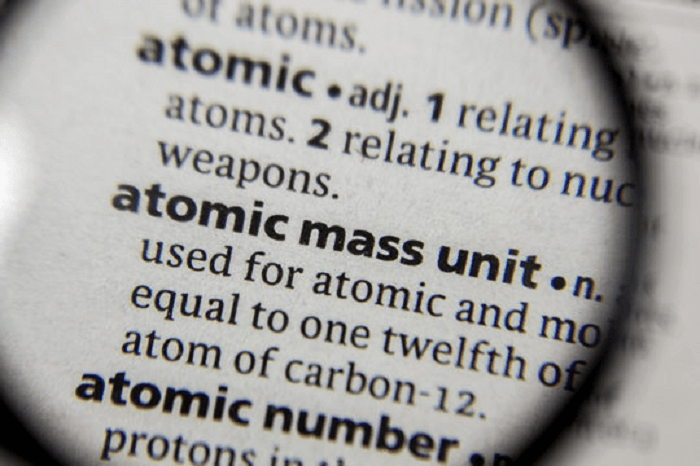Define One Atomic Mass Unit (a.m.u.)IntroductionThe unit of measurement known as the atomic mass unit (amu) is used for expressing the mass of atoms and molecules. It is frequently employed in the sciences of chemistry, physics, and biology. The Dalton (Da) and united atomic mass units are other names for the atomic mass unit. In particular, one-twelfth (precisely 1/12) of the mass of a single carbon-12 atom is exactly equal to the one atomic mass unit (1u). The atomic mass unit, or amu, is equivalent to 1.66 x 10^(-27) kg or 1.66 x 10^(-24) grams. One carbon-12 atom has a mass of 12 amu, consisting of six protons and six neutrons in its nucleus. The unit is extremely helpful for determining the weights of atoms and molecules because it measures such a tiny quantity of mass. In this article, we'll talk about the idea of the Atomic mass unit, its definition, applications in various areas, advantages and disadvantages, and a lot more things. So let's get started with another intriguing science concept right away. 
Definition of One Atomic Mass UnitAn atomic mass unit (amu) is a weight measure used to describe the masses of atoms and molecules. It is equivalent to 1.66 x 10^(-27) kilograms and is described as 1/12 of the mass of one carbon-12 atom. Concept of Atomic Mass UnitTo calculate the proportional weights of atoms and molecules, scientists use the atomic mass unit. Due to the ability to compare various elements and compounds, it is a useful unit of measurement. The proportional proportions of the elements in a compound or particle can also be ascertained with its aid. As an illustration, the atomic mass of hydrogen is 1 amu, whereas the atomic mass of oxygen is 16 amu. This indicates that there is 1 hydrogen element for every 16 oxygen atoms. A crucial component of biology and science is the atomic mass unit. In addition to calculating the weights of atoms, molecules, and other entities, it can also be used to gauge how much of each element is present in a compound or molecule. Scientific measurements and comparisons of the weights of various elements and compounds are made possible thanks to the atomic mass unit. In disciplines like physics, biology, and geology, it is frequently employed. The unified atomic mass unit and the Dalton (Da) are additional names for the atomic mass unit. Quantifying the relative weights of atoms and molecules requires the atomic mass unit. Amu is a unit of mass used in chemistry to determine the masses of atoms, ions, and compounds. It is employed in physics to calculate the weights of subatomic entities. It is employed in biology to calculate the masses of organic entities such as proteins. Now, we will go into more depth about its application in various fields. Usage of the Atomic Mass Units in Different AreasIn the physical disciplines, it is frequently used to determine the masses of elements like protons, neutrons, and electrons. The weights of atoms and compounds are also measured using the atomic mass unit in the fields of chemistry, biology, and other sciences. The calculation of a substance's molar mass in chemistry is done using the atomic mass unit. For this, the atomic weights of all the components of the substance are added together. In order to determine how much of a substance is contained in a solution or to measure how much is required to create a particular quantity of a solution, the molar mass is used. As atoms of the same element with varying amounts of neutrons are known as isotopes, the relative weights of these atoms are also measured using the atomic mass unit. Calculating a nucleus's binding energy in physics requires the use of the atomic mass unit. The bulk of the nucleus has an impact on this energy, which is needed to keep the nucleus together. Particle weights, including protons, neutrons, and electrons, are also measured taking atomic mass units into consideration. The mass of proteins and other biomolecules in biology is measured using the atomic mass unit. Various compounds and ions that are crucial to cellular respiration are measured by their masses as well. The composition and purpose of these compounds can be better understood by knowing AMU. In additional fields like geology and astrophysics, the atomic mass unit is widely used. It is employed in astrophysics to determine the masses of stars and planets. Additionally, the weights of rocks and materials are also measured using AMU in geology. The atomic mass unit is an essential tool for understanding the weight, structure and behaviour of matter in almost all scientific disciplines. The Bottom LineAtoms are the basic building blocks of our universe, and the atomic mass unit is a key to understanding the complex world of atomic structures. It has enabled us to discover the secrets of the atom and its components and has opened our eyes to the universe's immensity. It serves as a powerful reflection on the importance of information, precision, and accuracy when attempting to understand the world through science. It is clear that the atomic mass unit will remain an important pillar of scientific progress for many years to come, even though we are only now beginning to fully understand its significance.
Next TopicSome Daily Examples of Osmosis
|
 For Videos Join Our Youtube Channel: Join Now
For Videos Join Our Youtube Channel: Join Now
Feedback
- Send your Feedback to [email protected]
Help Others, Please Share









